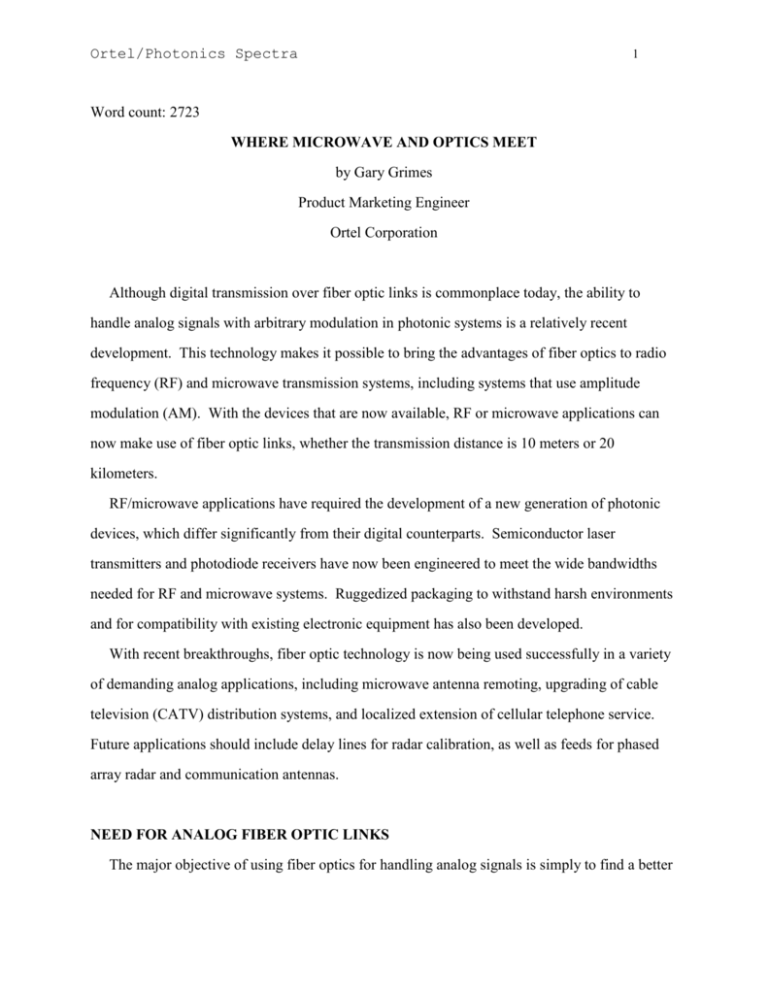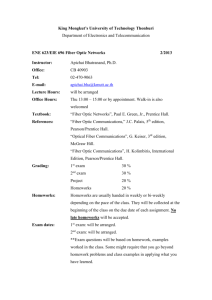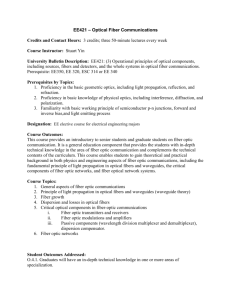ortel1 - La Puerta Productions
advertisement

Ortel/Photonics Spectra 1 Word count: 2723 WHERE MICROWAVE AND OPTICS MEET by Gary Grimes Product Marketing Engineer Ortel Corporation Although digital transmission over fiber optic links is commonplace today, the ability to handle analog signals with arbitrary modulation in photonic systems is a relatively recent development. This technology makes it possible to bring the advantages of fiber optics to radio frequency (RF) and microwave transmission systems, including systems that use amplitude modulation (AM). With the devices that are now available, RF or microwave applications can now make use of fiber optic links, whether the transmission distance is 10 meters or 20 kilometers. RF/microwave applications have required the development of a new generation of photonic devices, which differ significantly from their digital counterparts. Semiconductor laser transmitters and photodiode receivers have now been engineered to meet the wide bandwidths needed for RF and microwave systems. Ruggedized packaging to withstand harsh environments and for compatibility with existing electronic equipment has also been developed. With recent breakthroughs, fiber optic technology is now being used successfully in a variety of demanding analog applications, including microwave antenna remoting, upgrading of cable television (CATV) distribution systems, and localized extension of cellular telephone service. Future applications should include delay lines for radar calibration, as well as feeds for phased array radar and communication antennas. NEED FOR ANALOG FIBER OPTIC LINKS The major objective of using fiber optics for handling analog signals is simply to find a better Ortel/Photonics Spectra 2 transmission medium than coaxial cable. As its application in digital communications has already shown, optical fiber is a nearly ideal medium. Compared with metallic cable, optical fiber offers far lower signal loss, immunity to electromagnetic interference (EMI), huge savings in cross-sectional area and weight, inherent security (lack of radiation and resistance to tampering), and exceptionally wide bandwidth. For comparison, a graph of the frequency response of single-mode optical fiber versus coaxial cable is shown in Figure 1. The fact that these benefits have been realized for some years in digital fiber optics is no guarantee of success with analog transmissions. Compared with digital signal transmission, analog RF and microwave transmissions cover a much wider spectrum. And, the signal-to-noise ratio (S/N) for analog systems--particularly AM systems such as CATV--must be much higher than in digital systems. These requirements call for fiber optic laser transmitters with low noise. With specially engineered devices, a number of important RF and microwave frequency bands are now well within the range of current analog fiber optic technology. In fact, signal transmission at frequencies as high as 18 GHz has been demonstrated experimentally. A graph of S/N versus frequency in a high-speed fiber optic link is shown in Figure 2. ANALOG FIBER OPTIC TECHNOLOGY Elements of the new analog fiber optic technology include: Semiconductor lasers Photodiode receivers RF/microwave fiber optic transmitters and receivers Single-mode optical fiber Low-noise link design. Ortel/Photonics Spectra 3 Semiconductor Lasers Semiconductor lasers used as analog photonic transmitters are based on ultra-high speed gallium arsenide diodes. A very reliable type has been the InGaAsP laser, which radiates at a wavelength of 1.3 um, or in the near-infrared. A GaAlAs laser, with a wavelength of 8.4 um, is also available. The design of these lasers is termed Fabry-Perot (FP). In an FP laser, the diode is a resonant cavity structure that emits coherent light when biased above threshold. FP lasers are available with 3, 6, or 10 GHz modulation bandwidths. The 10 GHz model has been tested up to 18 GHz. The modulation characteristics of an FP laser are graphed in Figure 3A. As shown in the graph, the transfer of the electrical RF signal to modulated optical light power (mW) is highly linear and free of distortion. Besides operating frequencies and bandwidth, another major difference between conventional laser designs and those used for analog signaling is physical packaging, as shown in the accompanying photos. The laser module shown is equipped with a standard 50-Ohm coax connector for RF input, with a mini connector for a control circuit wiring harness. All connections are gold plated, and the module is hermetically sealed. By contrast, a laser module designed primarily for computer and telecommunication applications usually is housed in a 14pin package for permanent connection to a printed circuit board. Instead, the design of the analog fiber optic laser package provides for a screw-down mounting plate, which also serves as a heat sink. With its standard connectors, this design is more compatible with existing RF/microwave equipment and assures quick-disconnect and easy swapping if replacement becomes necessary in the field. Ability to withstand harsh environments is a common requirement of RF/microwave applications. Like many other advanced semiconductor devices, microwave lasers were developed originally for the military to very high standards of reliability. Packaging adheres to MIL standards for shock and vibration, humidity (60o C at 95% R.H.), and temperature (-40o to Ortel/Photonics Spectra 4 +70o C). To achieve stable operating temperature, the laser diode is mounted on a special thermoelectric cooler that heats or cools the laser as needed to keep the diode temperature to within +/- 2o C of the specification. High-Speed Photodiodes Analog photonic receivers also stem from gallium arsenide technology. A proven configuration for fiber optics uses an InGaAs photodiode in a low-noise PIN design. As shown in the graph in Figure 3B, these devices convert incoming modulated light into electrical current with excellent linearity and virtually no excess noise. Like the FP lasers described above, photodiodes designed for analog fiber optics have hermetically sealed case modules with gold-plated RF connectors and screw-down mounting plates. Like the laser modules, photodiodes are now available in 3, 10, and 12 GHz bandwidths. Since these photodiode devices were developed in conjunction with the FP laser modules, they withstand the same MIL standard tests for rugged use. RF/Microwave Fiber Optic Transmitters and Receivers Fiber optic transmitter and receiver equipment has been built around these FP lasers and photodiodes. Besides the FP laser itself, important functions of the laser transmitter include bias and matching of RF input, monitoring and automatic leveling control of DC power to keep average laser light constant, and thermoelectric cooling for regulating the operating temperature of the laser diode. Functions of the photodiode receiver circuitry include diode bias regulation and monitoring. In addition to the 3, 6, and 10 GHz frequencies discussed above, transmitters and receivers may also be set to optimize operation at a particular frequency, as in broadband video. Analog fiber optic receivers typically operate over very wide bands but also are available with postamplifiers for the 0.01 to 2 GHz RF band or the 2 to 6 GHz microwave band. Application- Ortel/Photonics Spectra 5 specific configurations include TVRO (television receive only) fiber optic links, which are used to transmit the LNB output from a satellite earth station antenna to a remote receiver, as well as CATV links that transmit multichannel AM video signals. Single-Mode Optical Fiber The preferred medium for microwave fiber optics is single-mode optical fiber, which is tuned to a specific wavelength for maximum bandwidth. The laser wavelength is typically 1.3 um (1300 nm), although 0.84 um (840 nm) can also be used. Recent advances in the manufacture of optical fiber and termination techniques are making photonic links increasingly economical. For example, lightweight fiber can be blown readily through cable ducts, either replacing or supplementing existing wire cable. For field use, cables with special protective jackets have been developed that resist weathering, corrosives, and other environmental hazards. Low-Noise Link Design Concerns that affect laser/photodiode linearity and noise, which may not be especially critical in digital applications, become very important in the RF/microwave arena. These concerns include: Reflections back to the laser Impedance matching. Reflections. A persistent problem in fiber optics is that optical connectors and the receiving photodiode tend to reflect a portion of the incoming signal back down the fiber toward the transmitter. Optical reflections back into the laser cause additional laser light intensity noise, which, in turn, becomes electrical noise at the ends of the link. In long-distance digital applications, where fiber run lengths may exceed 50 km, the natural attenuation of the fiber over Ortel/Photonics Spectra 6 distance (a fraction of a decibel per kilometer) will serve to dampen this effect. Analog links, which typically are less than 20 km and may be as short as a few meters, can be particularly susceptible to reflections. If sufficient signal is reflected, the resulting noise and distortion can adversely affect the operation of the entire link. In the photodiode module shown in the accompanying photos, reflections have been virtually eliminated by a proprietary process of fiber termination. The real engineering achievement here has been to eliminate the reflections without attenuating the signal itself. As a result, photodiodes with this type of fiber termination are much more suitable for RF/microwave applications than conventional devices designed for digital fiber optics. Other design steps have been taken to minimize the effects any reflections on the laser transmitter. Impedance matching. A photodiode serves as a current source for the RF device to which it is connected. Ideally, the impedance of the two devices should match. Otherwise, an effect called mismatch ripple is induced in the frequency response. This effect can be particularly troublesome in microwave systems. Mismatch ripple can be avoided by including matching resistors in the packaging of laser and photodiode modules that are designed for analog signaling. The devices shown in the accompanying photos are matched to the 50-Ohm characteristic impedance of RF/microwave electronics. BENEFITS IN APPLICATIONS Benefits of fiber optics in RF/microwave applications are summarized in the table in Figure 4. The discussion below highlights some typical uses of analog fiber optic links. Antenna Remoting As shown in Figure 5, fiber optic links make it possible to locate antenna arrays far from Ortel/Photonics Spectra 7 demodulators and other bulky and/or environmentally sensitive station equipment. Mobile antenna systems can even be supported using fiber optic cables that spool out from vans or transports. Such links, which connect portable antennas to central station equipment with temporary fiber optic links, are currently in use in tactical military systems. Other opportunities for antenna remoting include inter-facility links for satellite ground stations at intermediate frequency (IF), C-band, or Ku-band (microwave bands). In telemetry tracking systems, fiber optic links make it possible to locate receivers at a convenient and safe distance from the antenna pedestal, while maintaining a secure link between the antenna and the receiver. Commercial radio stations can now use optical fiber to link the broadcast studio, perhaps in a crowded urban location, with a distant antenna atop a mountain or skyscraper. CATV An immediate, economic motivation for using fiber in CATV distribution is to cut down on the need for repeaters and improve signal quality to customers who are on the fringes of the network. Conventional coax distribution requires a repeater every 1500 ft. Within an existing CATV distribution network, the number of repeaters can be reduced and signal quality can be improved with the addition of a fiber optic "backbone," as shown in Figure 6. In many cases, signal quality will be improved (especially in outlying areas), and the network will be less vulnerable to individual amplifier failures. (The concept of fiber optic backbones for CATV was pioneered by American Television Corporation, which is owned by Time, Inc.) A primary reason to use fiber optics in cable television is to reduce cable size and therefore the cross-sectional area of ducting, which usually must be leased from a public utility or municipality. Typically, one thin fiber can replace a 2-inch bundle of metallic cable. Ultimately, it may be desirable to replace much of public CATV distribution systems with fiber to reduce or eliminate the low-level neighborhood EMI that radiates from these systems. The FCC has stated that Multiple System Operators (MSOs) in CATV eventually will be responsible for reducing the interference generated by their systems. Ortel/Photonics Spectra 8 Avionics/Shipboard Navigation The digital "fly-by-wire" avionics on military and commercial aircraft already are being replaced with fiber optic data buses. The development of analog fiber optics now makes it possible to include microwave, radio, and radar circuits in the new designs. Besides the advantages of greatly increased bus speed and capacity, fiber optics also saves space and weight-perhaps as much as two tons on a large, commercial airliner. In military or commercial aircraft, direct benefits of lightweight designs also include increased payload and fuel economy, and reduced mission/flight time. In maritime applications, fiber optic links are most attractive for reducing the bulk and weight of microwave links above the water line. For example, heavy cabling and waveguides can be eliminated between the conning tower and the bridge. And, should the conning tower be damaged by attack or storm, a temporary fiber optic link is more easily rigged. Of course, with thin, lightweight fiber, the space and weight penalties of designing in redundant links are also eliminated. Phased Array Radar The next generation of phased array radar systems, as well as steerable communication antennas, will need to feed hundreds--perhaps thousands--of radiating elements. Advanced technical planners are now considering the advantages of microwave fiber optic links for transmitting and receiving signals from the antenna array. The fibers can be bundled in a package that has low weight and cross-sectional area. Also, due to the properties of fiber optic transmission, cross-talk between individual feeds will be nonexistent. Radar Delay Lines Fiber optics represents a potential breakthrough for use in delay lines for radar systems and Ortel/Photonics Spectra 9 military early warning (EW) equipment. Delay lines perform a variety of functions, including built-in test (BIT), memory loops, and delay for sequential processing of high-speed transient signals. Formerly, delay lines have been implemented with large coils of coaxial cable or with bulk acoustic wave (BAW) devices built around crystals of lithium niobate. The transmission delay of coaxial cable is about 5 ns/m. Considering the bulk of a large coil, a feasible delay is on the order of 200 to 300 ns. Lithium niobate devices extend this range to perhaps 1 to 2 us, maybe as much as 10 us in extreme cases. The delay caused by optical fiber is about 5 microseconds per kilometer. That is, 10 km of coiled fiber will cause a delay of 50 us. Since several kilometers of fiber can now be coiled into a package small enough to hold in your hand, fiber optic delay lines can be built to produce delays that would be unattainable by other means. Delays of up to 100 us are known to be feasible, and up to 500 us (a full half millisecond) is theoretically attainable. Even for relatively short delays, fiber optic delay lines may be preferred to wire coils or BAWs. Reasons include exceptional linearity of phase response, extremely wide (multi-octave) bandwidth, potentially less than 20 dB of insertion loss, extremely low triple transit signals (reflections), and excellent signal quality. Cellular Telephony A recent application of fiber optics has been to extend cellular telephone coverage to "shadow" locations, or sites that are obscured from the main antenna for the local cell. Such sites include bridges, underground parking structures, tunnels, and the far sides of tall buildings. Fiber optic links can be run from the nearest transmission node to an antenna within the shadow area. SUMMARY The prospects for fiber optics in RF/microwave applications can be illustrated with a central Ortel/Photonics Spectra 10 example: Analog fiber optic links now permit location of remote components (such as antennas) and RF/microwave station equipment in separate, optimum locations that are as much as 20 km apart, without repeaters. This design flexibility has potential use in any transmission system that handles analog signals--within the range of a few hundred kHz to 18 GHz. ### Ortel/Photonics Spectra 11 SUGGESTED LIST OF ILLUSTRATIONS Figure 1. Graph. Attenuation (dB/100 m) vs. Frequency (MHz). COMPARISON OF SIGNAL LOSS, OPTICAL VS. COAXIAL CABLES Figure 2. Graph. Maximum S/N Ratio (dB/Hz) vs. Frequency (GHz). SIGNAL-TO-NOISE RATIO OF HIGH-SPEED FIBER OPTIC LINK. Figure 3. Graphs. A. Output Light Power (mW) vs. Input Current (mA). MODULATION CHARACTERISTICS OF A SEMICONDUCTOR LASER. B. Output Light Power (mW) vs. Input Light Power (mW). PHOTODIODE RESPONSIVITY. Figure 4. Table of analog fiber optic applications and benefits. Figure 5. Diagram. Antenna remoting by fiber optic link. Figure 6. Diagram. CATV fiber optic backbone added to existing coaxial distribution system. PHOTOS: Tabletop views of semiconductor laser and photodiode modules. Fiber optic transmitter and receiver equipment. ###







